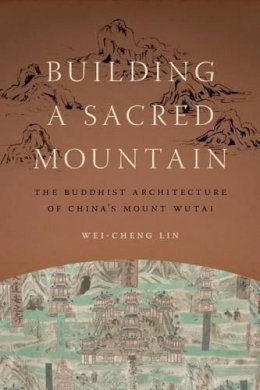
Building a Sacred Mountain: The Buddhist Architecture of China's Mount Wutai (A China Program Book / Modern Language Initiative)
Wei-Cheng Lin
By the tenth century CE, Mount Wutai had become a major pilgrimage site within the emerging culture of a distinctively Chinese Buddhism. Famous as the abode of the bodhisattva Mañjuśrī (known for his habit of riding around the mountain on a lion), the site in northeastern China’s Shanxi Province was transformed from a wild area, long believed by Daoists to be sacred, into an elaborate complex of Buddhist monasteries.
In Building a Sacred Mountain, Wei-Cheng Lin traces the confluence of factors that produced this transformation and argues that monastic architecture, more than texts, icons, relics, or pilgrimages, was the key to Mount Wutai’s emergence as a sacred site. Departing from traditional architectural scholarship, Lin’s interdisciplinary approach goes beyond the analysis of forms and structures to show how the built environment can work in tandem with practices and discourses to provide a space for encountering the divine.
Art History Publication Initiative. For more information, visit http://arthistorypi.org/books/building-a-sacred-mountain
Product Details
About Wei-Cheng Lin
Reviews for Building a Sacred Mountain: The Buddhist Architecture of China's Mount Wutai (A China Program Book / Modern Language Initiative)
John Renard
Religion and the Arts
"Reflects a remarkably ambitious and rigorous scholarly undertaking. It illustrates the reciprocal relationship between a unique geographic phenomenon and a sensitive and enlightened human response. The wide-ranging and exhaustive research that supports this book will give it enduring value to a wide range of scholars."
Choice
"[T]he overall themes of visions, buildings, and pilgrimage that run throughout this beautifully illustrated, meticulously documented book are consistently compelling: there was, Lin demonstrates, much more to building Wutai than buildings."
John Kieschnick
Journal of Asian Studies
"As Lin’s insightful work makes abundantly clear, through the ontology of Wutaishan—from mountain, to monastery, to mandala, to mural, and from vision to built environment—Mount Wutai was always something like a ‘virtual mountain.’"
Johan Elverskog
American Historical Review
"[A] rich and nuanced historicization of Mount Wutai’s ascent and transformations from the third through the tenth century, and an insightful account of the ever-shifting and contextual grounds of sacred geography. Lin’s book is a substantial contribution to the recent wave of scholarship on Mount Wutai, but it’s impact will be felt well beyond the borders of this subfield. . . . Elegantly written and produced. . . . [A] careful reader is rewarded with an expanded vista from which to see the Foguang Monastery, and through which to enter the field of sacred geography anew."
Wen-shing Chou
Monumenta Serica
